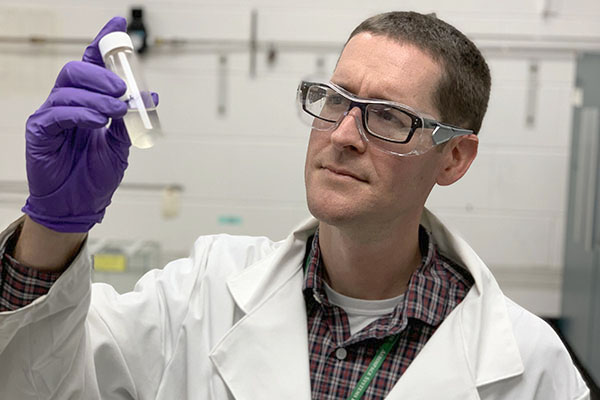Fouled fuel

Fouled fuel
Researchers identify contaminants that caused multiple jet engine failures
By Pamela Gregg, Communication Administrator, 937-229-3268
The tiny white clusters in the jet fuel sample were all too familiar. Steve Zabarnick and his fuels research team at the University of Dayton Research Institute had seen them before, during a study related to low-temperature jet-fuel freezing. So when they were asked to help determine the cause of multiple related inflight aircraft engine failures, the researchers were quickly able to identify the culprit.
The white clusters, formed when urea bonded with large normal alkanes (carbon chains) in the jet fuel, clogged filters, nozzles and other parts of the aircraft fuel systems. Urea is not naturally found in fuel; it was introduced when an aircraft refueling technician inadvertently added what he thought was an icing inhibitor into fuel that was then pumped into the engines of several aircraft. Instead, he’d added diesel exhaust fluid (DEF), a urea-based solution designed to reduce polluting emissions from refueling trucks.
The UDRI fuels research team first identified the problem in 2017, after several military and civilian jets were unintentionally serviced with DEF-contaminated fuel at Eppley Air Field Airport in Omaha, Neb. Since then, at least three aircraft have experienced in-flight engine flameouts or other issues resulting from two separate DEF-contaminated fueling events in 2018 and 2019. In the most recent event, two air ambulances fueled at Punta Gorda Airport, Fla., and carrying patients to disparate locations, were forced to make emergency landings after engine failure.
Although affected aircraft from all three events were able to land safely—including an air ambulance that lost both engines—there have been several close calls. And Zabarnick believes all aircraft involved are no longer airworthy, since there is no way to flush the urea complex from the fuel systems.
Zabarnick said the problem started after a 2014 mandate by the Environmental Protection Agency required DEF to be added to the exhaust systems of off-road, diesel-fueled ground vehicles—including airport refueling trucks—to reduce the amount of nitrogen oxides and other harmful pollutants in vehicle emissions. Airport operators began storing DEF onsite to service refueling trucks, but the clear, colorless liquid is identical in appearance to fuel system icing inhibitor (FSII), an additive designed to keep trace water in jet fuel from freezing at cold temperatures.
“If DEF and FSII are stored in similar style containers and not properly labeled, it would be visually impossible to tell them apart,” Zabarnick said, adding that reports from the Federal Aviation Administration and National Transportation Safety Board indicate misidentification at the root of all three contamination events.
“When urea is added to ground vehicle emissions systems in the form of DEF, it binds with nitrogen oxides and other pollutants and prevents them from getting through the exhaust system and into the air. But when urea is added to fuel, it binds with hydrocarbons to form clusters of crystals that will clog filters and other fuel systems components. These crystals are not soluble in fuel, so it’s virtually impossible to flush or otherwise remove them from the fuel system—meaning the engine is irreparably damaged.
Ironically, it was their 2002 study into the potential of using urea to lower jet fuel freeze points that helped the research team quickly identify urea contamination as the cause of the engine failures in 2017. “We were able to show that urea selectively binds with and removes the long-chain hydrocarbons in jet fuel that cause it to freeze, but the process generates large quantities of clumpy white deposits. So when we saw the same types of clusters in the fuel samples we received in 2017, we quickly suspected they were urea-alkane based.”
Using gas chromatography, a process which isolates components of a solution for identification, the researchers confirmed their suspicion.
Since then, the fuels team has worked closely with the Federal Aviation Administration during investigations into related engine failures in 2018 and 2019, confirming each time that urea-alkane complexes were present in the fuel systems of the affected aircraft.
“It’s important to note that this issue has only been seen in aircraft for which FSII is injected during refueling, such as business and military jets,” Zabarnick said. “The vast majority of commercial passenger flights will not be affected, because they do not require FSII.”
Zabarnick said a report issued in June by a working group of FAA and industry participants indicates that the risk of DEF contamination is still high, but that efforts are in place to mitigate that risk. The comprehensive report, which discusses the contamination events and includes safety resources from the FAA, the Aircraft Owners and Pilots Association and the National Air Transportation Association, recommends a number of short- and long-term actions and processes designed to prevent contamination for aircraft and airport operators, fuel suppliers and others—including distinct labeling for FSII tanks and dyeing DEF a unique and distinguishable color; NATA now offers free training on contamination prevention and free decals for DEF storage containers.
“We know the industry is working on measures to prevent contamination, which could include standardized containers, couplings, and pipes and hoses for fuel dispensing equipment,” Zabarnick said. “We believe the risk for DEF-related jet fuel contamination can be greatly reduced as these and other safety measures are put in place.”
Dec. 19, 2019
Steve Zabarnick is head of the University of Dayton Research Institute’s Fuels and Combustion division. Researchers conduct basic and applied research in combustion, energy conservation, environmental engineering, fuel science, fuels engineering, and modeling and simulation, and develop and test cleaner burning and more environmentally friendly fuels.
